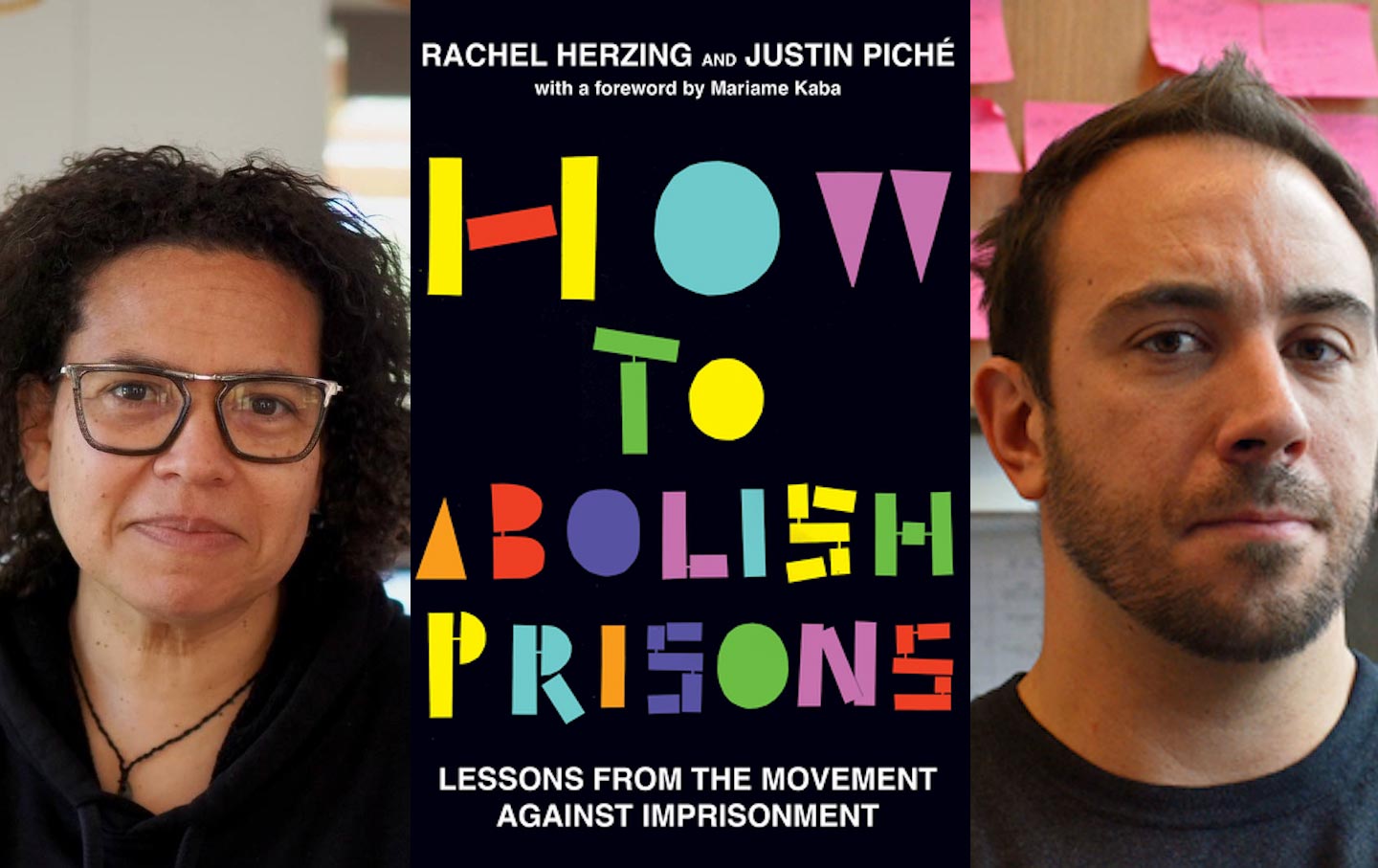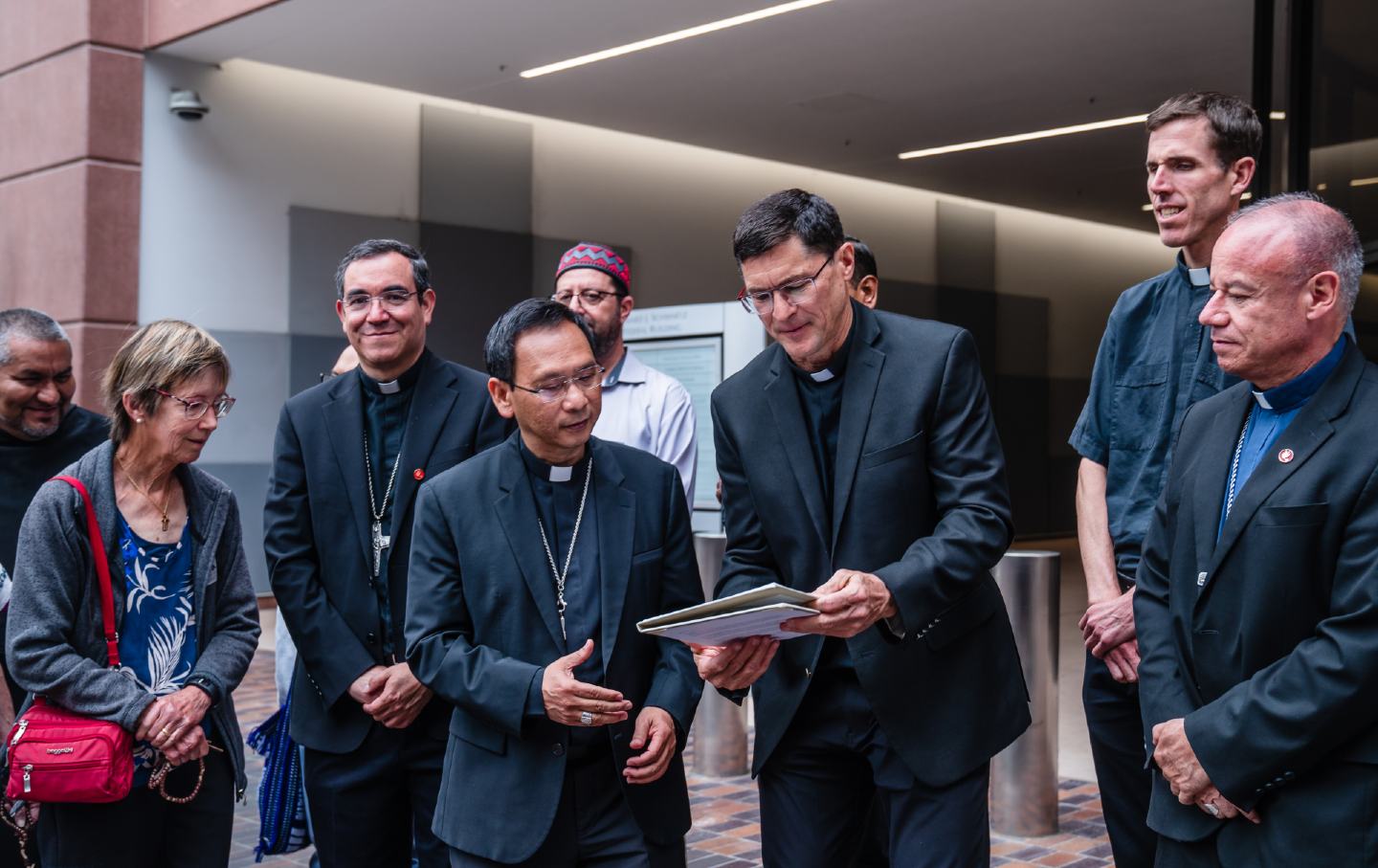The Work of Abolishing Prisons: A Q&A With Rachel Herzing and Justin Piché
A conversation with Rachel Herzing and Justin Piché about their new book, How to Abolish Prisons: Lessons from the Movement Against Imprisonment.

The start of the Covid-19 pandemic and, two months later, the police murder of George Floyd sparked worldwide protests and a renewed interest in both police and prison abolition. Demands to defund the police intersected with calls for decarceration (or reducing the numbers of people imprisoned). Both gained traction during the pandemic’s most terrifying days when jails and prisons quickly became hot spots for Covid spread and people behind bars died at more than three times the rate of their outside counterparts.
While 2020 was the first time that many had heard these demands, they were not new. They were the result of decades of sustained organizing, which had “prepared fertile ground for the seeds of abolitionist politics,” write Rachel Herzing and Justin Piché in their new book, How to Abolish Prisons: Lessons from the Movement Against Imprisonment. Herzing and Piché have spent decades in movements to abolish prisons in the United States and Canada. How to Abolish Prisons demonstrates the diversity of abolitionist tactics—from formal campaigns to shutter jails and prisons to forming mutual aid efforts that also create space for conversations about abolition outside the activist milieu, from legal advocacy to creating art that challenges the legitimacy and inevitability of imprisonment.
—Victoria Law
Victoria Law: What made you decide to write How to Abolish Prisons? What are you hoping it will accomplish?
Justin Piché: Over several decades, a lot has been written on why abolition, abolitionist critiques of imprisonment, and alternatives to imprisonment. As organizers and thinkers around prison abolition, we thought, “Why not focus on the ‘how’ question? How are people doing this work? How are they organizing and structuring themselves to sustain this work?”
VL: You start with Jerome Miller, who was appointed the director of Massachusetts’ Department of Youth Services in 1969. After trying to reform the state’s youth prisons, called “training schools,” he closed them. What can contemporary readers learn from the Massachusetts Experiment?
Rachel Herzing: Jerry Miller is a big hero to a lot of us in the US prison abolitionist movement. He came in as a reformer. He tried to increase training for staff, programs for the young people, improve conditions, etc. He was not seeing substantial transformations, so he went about closing these youth prisons. Rather than saying, “Who are the nicest children who are locked up? Let’s get them out,” he said, “Who are the people that the local communities might be most afraid of? If we can figure out a remedy for them, the rest will be easier.”
That’s really instructive. Rather than tinkering with the easiest bits first, he asked, “What is the biggest problem that we have? How can we try to address that?”
Jerry Miller is the name that’s associated with these closures. But there were many, many people involved in the organizing, putting pressure on legislators, advocating on behalf of young people, and making all of that happen. It was a broad-based effort.
JP: The act of destroying the buildings and selling the land is critically important. Sites of confinement, when they are decommissioned, oftentimes are repurposed to meet some other confinement need, like immigration detention becoming prisons, or prisons becoming immigration detention. There’s also carceral retasking, where you transform these sites into other uses that reproduce imprisonment as a dominant idea, like prison tourism sites that reproduce establishment narratives or prison-themed escape rooms.
VL: On April 15, the US Bureau of Prisons [BOP] announced the immediate closure of a federal women’s prison in Dublin, California, one week after a judge appointed an independent monitor to oversee the scandal-plagued facility. But the BOP director stated that no employees will lose their jobs—though staff sexual abuse was the catalyst for such public outrage—and incarcerated people would be transferred (in many cases to prisons further from home), not released. Is it an abolitionist win when a prison is closed, but the people inside are simply shuffled to other prisons?
JP: If you close a prison, and it’s replaced by a larger prison, is that a victory? One would say no. If a prison becomes the site of prison tourism, is that a victory? It’s still reproducing the idea that imprisonment is necessary and doing the ideological work of the prison-industrial complex.
Is the closure shrinking the prison footprint? If so, it’s a victory. If not, if it’s still performing symbolic and material work that allows the caging of more people, even though this one shitty building closes, imprisonment continues in the newer building.
RH: What we saw in Miller’s Massachusetts experiment is exceptional. It’s much more common to do the Titanic deck chair shuffle rather than any meaningful decarceration.
If the end game is not to substantially decrease the size, scope, and legitimacy of the system, then people will just get shuffled around, whether guards or imprisoned people. That’s why the goal of abolishing imprisonment is key. Otherwise, we wind up with this shell game.
If you care about conditions of confinement, conditions will only be worse [with] the more people you cram into a single prison. If you care about connections between imprisoned people and their loved ones and with their home communities, or their ability to leave prison and not return, then distancing them from loved ones and their home communities reduces those likelihoods.
We also know that the more people you cram into a single prison, the more dire the conditions become for everybody, including the people who work there.
VL: You write, “Sometimes even ‘unsuccessful’ campaigns may lay a foundation that makes future fights easier.” Can you elaborate on that?
RH: In the late 1990s and early 2000s, Critical Resistance was part of a coalition to stop a prison slated to be built across the street from an existing prison in Delano, California, home of the United Farmworkers. The organizers fought on a number of different grounds, including environmental grounds and, in doing so, cut new territory in terms of how imprisonment was fought. Calling imprisonment an environmental hazard and a polluting industry was new at that time, as was fighting on the grounds of endangered species acts.
The organizers ultimately lost. That prison was built. There are people caged in it today. But the style of organizing developed a template.
Today, environmental challenges to prisons are quite common. That was a net boost for the movement, even though Delano was technically a complete loss.
JP: In 2016, there was crowding at the Ottawa-Carleton Detention Centre (OCDC). Often two to three people were in cells originally constructed for one person. There were even people housed in the showers. That caught fire in the media, and all kinds of political pressure was put on local members of Parliament, the attorney general, and the minister of prisons. They announced a task force to try and address conditions.
Our group, the Criminalization Punishment Education Project, submitted a report on conditions to address some of the most egregious things. We did another on how to divert and decarcerate people to empty out OCDC.
In Ontario, the vast majority of people in our provincial jails are awaiting their day in court. We proposed diversion measures like more consent bail agreements between crown and defense attorneys.
We proposed decarceration measures like getting rid of having people serve sentences over the weekends. If they’re out in the community, working and with their families during the week, why lock them up on weekends?
Ontario government officials said, “No, we can’t do that. The courts mandate the sentences; we just execute them.”
Then the pandemic comes along and they pick up those demands. We had a Contain COVID Not People campaign that started with the Toronto Prisoners’ Rights Project. Early in the pandemic, hundreds of organizations supported those demands and we were able to put pressure on the system. The prison went from about 600 people to around 300 within a matter of weeks. Sometimes the demands and the organizing don’t work, but they lay a foundation in terms of ideas and relationships, so that when the next turning point comes, you’re able to execute the pressure more.
The challenge afterwards was to defend those gains. Our opponents are always thinking of new ways to reassert their legitimacy and power. If we don’t find ways to defend our gains, we often have those scraped back.
As Norwegian sociologist and organizer around prison abolition Thomas Mathiesen, said, it’s an unfinished project. We have to be prepared to continue to fight even after we win.
Disobey authoritarians, support The Nation
Over the past year you’ve read Nation writers like Elie Mystal, Kaveh Akbar, John Nichols, Joan Walsh, Bryce Covert, Dave Zirin, Jeet Heer, Michael T. Klare, Katha Pollitt, Amy Littlefield, Gregg Gonsalves, and Sasha Abramsky take on the Trump family’s corruption, set the record straight about Robert F. Kennedy Jr.’s catastrophic Make America Healthy Again movement, survey the fallout and human cost of the DOGE wrecking ball, anticipate the Supreme Court’s dangerous antidemocratic rulings, and amplify successful tactics of resistance on the streets and in Congress.
We publish these stories because when members of our communities are being abducted, household debt is climbing, and AI data centers are causing water and electricity shortages, we have a duty as journalists to do all we can to inform the public.
In 2026, our aim is to do more than ever before—but we need your support to make that happen.
Through December 31, a generous donor will match all donations up to $75,000. That means that your contribution will be doubled, dollar for dollar. If we hit the full match, we’ll be starting 2026 with $150,000 to invest in the stories that impact real people’s lives—the kinds of stories that billionaire-owned, corporate-backed outlets aren’t covering.
With your support, our team will publish major stories that the president and his allies won’t want you to read. We’ll cover the emerging military-tech industrial complex and matters of war, peace, and surveillance, as well as the affordability crisis, hunger, housing, healthcare, the environment, attacks on reproductive rights, and much more. At the same time, we’ll imagine alternatives to Trumpian rule and uplift efforts to create a better world, here and now.
While your gift has twice the impact, I’m asking you to support The Nation with a donation today. You’ll empower the journalists, editors, and fact-checkers best equipped to hold this authoritarian administration to account.
I hope you won’t miss this moment—donate to The Nation today.
Onward,
Katrina vanden Heuvel
Editor and publisher, The Nation








